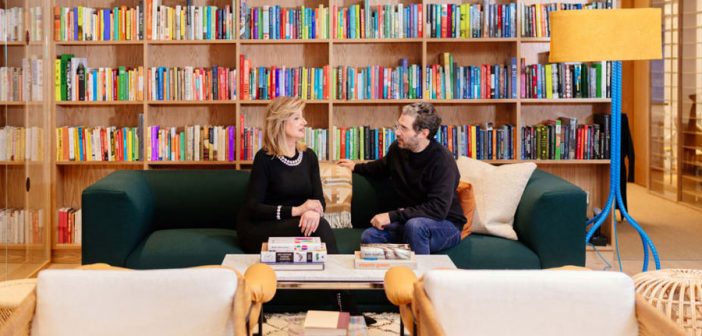WeWork chief creative officer Adam Kimmel gives Thrive Global, Arianna Huffington’s new wellness startup, a cozy look that could nearly pass for Huffington’s apartment.
Adam Kimmel has a cough. I’m sitting with the fashion designer and WeWork chief creative officer in Arianna Huffington’s office at a round table scattered with white porcelain dishes of lemons, chocolate, macadamia nuts, and dried fruit. We’re getting ready to discuss the cozy new headquarters for Huffington’s wellness company, Thrive, which Kimmel designed. Across the way is a plush living room set up with comfortable seats in muted green and beige tones. Here, I feel like I’m sitting at a kitchen table in a Manhattan loft. But before we begin, Huffington empties out a wicker box full of Immunitone, oregano oil, Zhong Gan Ling, and other cold-fighting supplements that she stocks up on at the advice of her herbalist. “So much of [wellness]is really building your immune system,” she says, as she opens up a bottle of pills. Kimmel takes the handful of pills readily and throws them into his mouth, taking in the full Thrive experience.
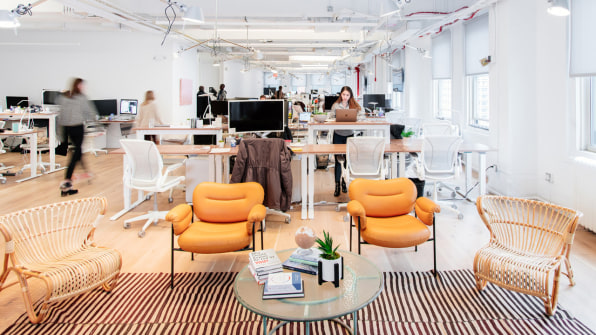
The office is the latest proving ground for HQ by WeWork, WeWork’s lightweight design, renovation, and office management service for startups. WeWork built its reputation renting coworking spaces, but has spent the past year developing a way to design office space for other companies, essentially acting like an architect or an interior designer. Why would a company choose WeWork over Gensler or Studio O+A, or any of the other excellent architecture and design firms out there? Crucially, WeWork also offers to manage office operations. So in addition to handling the design work, WeWork will coordinate daily cleaning, trash removal, and systems maintenance; it will even make sure the toilet paper is stocked.WeWork is betting that by turning itself into a one-stop, design-and-maintenance shop, it can make good on its $47 billion valuation, allowing companies to offload the responsibility of creating and managing a physical office space. WeWork, for its part, becomes an indispensable service, particularly as a company expands and needs additional office space over time. While WeWork’s custom office offering for larger enterprises is currently its fastest growing segment, the company sees HQ by WeWork as an opportunity to prime budding startups for a future with WeWork. HQ by WeWork was first announced in August, and WeWork expects to sign 100 such projects in 2019.
No company better illustrates the lofty ambitions of HQ by WeWork than Thrive. Though it’s run by Arianna Huffington–world-famous media mogul–it’s a small, 75-person office, with plans to hire 25 more people. If WeWork gets its hooks in now, Thrive could prove a lucrative partner in the long run.
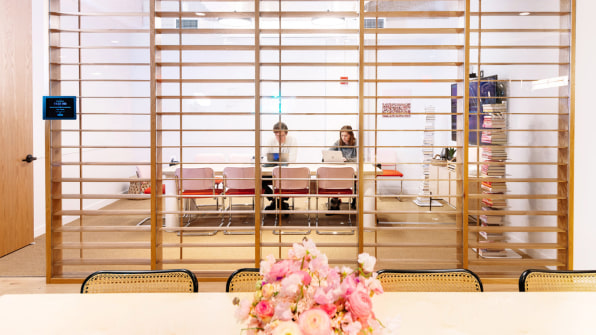
As for Kimmel’s design: It’s unfussy and projects the fresh, relaxed vibe on which Thrive is building a business. There’s a wooden dining table in the kitchen and a midcentury-furnished reception area with an assortment of colorful books on wall-to-wall shelves.
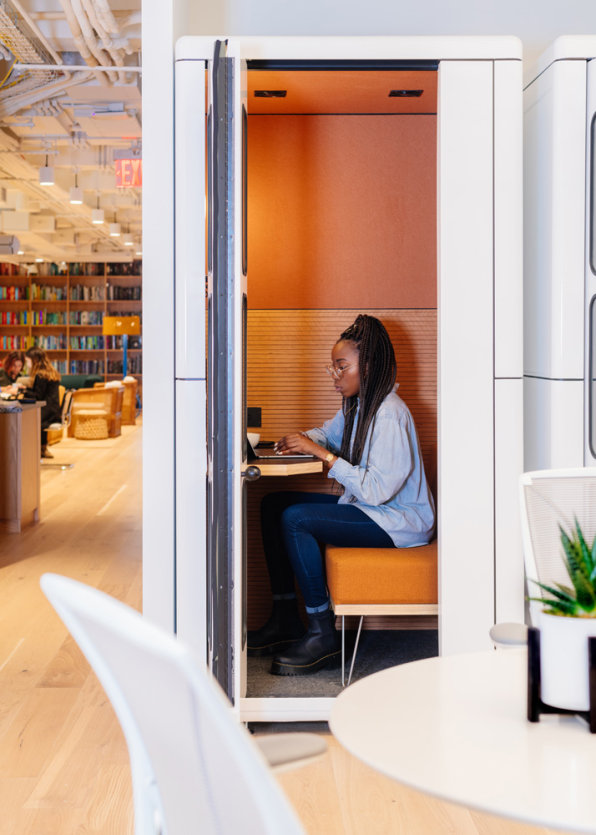
Huffington’s personal office is filled with her own furniture: an overstuffed couch, two plump sitting chairs, and a rustic coffee table. On a side table sits a tiny bed, where visitors are supposed to tuck in their cell phone to give it a rest–a Huffington invention. The wall-length glass windows that separate Huffington’s office from her team are covered in the largest wooden Venetian blinds I’ve ever seen, making the space feel like a living room. The surrounding walls are decorated with paintings made by her daughter, artist Isabella Huffington.
“We’re at this shift in office design in the world in general where people really want that more relaxed, homey feeling in the workplace,” says Kimmel, “just something more cozy and comfortable and cushions that are soft and breaking up the sea of desks with little living areas and books, bookshelves.”
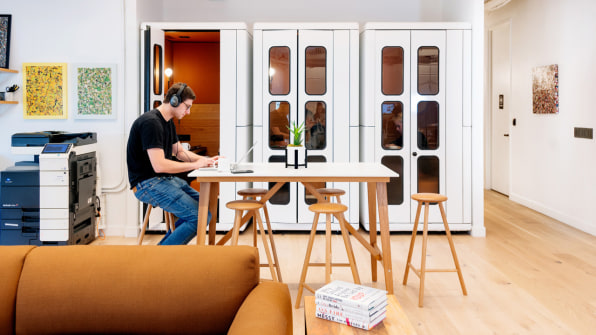
Of course, it’s not all couches and supplements. Much of the space’s aesthetic is straight from the WeWork playbook, familiar to anyone who’s worked in one of the company’s comfortable, if sterile, coworking spaces. Most of Thrive’s employees sit at white desks in a large open office area. Some employees huddle in pairs inside WeWork’s signature phone booths for small meetings. Conference rooms have long tables nestled with two-toned chairs (but have the same wooden blinds as Huffington’s personal office). When I was there, the espresso bar, a signature of most WeWork spaces, was still being set up. There is also a video editing suite, recording studio, and a wellness room, which is intended for breast-pumping mothers and which the company uses for weekly employee massages. Kimmel has also set up a few living room-like areas with couches to break up the desks.
To Huffington, an important aspect of the WeWork relationship is the ability to make changes to the space quickly as her company’s needs evolve. “If you say to Adam, I think we need a bigger board table, because we can’t fit the leadership team around it–they have stuff in storage,” she says, noting that if she were to independently order new furniture it might take months to arrive. So far, changes have been minor. Huffington asked for cosmetic changes in the bathroom, more cushions and seating in the wellness room, and sound-proofing in the studio.
Furthermore, Huffington, who is managing a growing startup, doesn’t have the time or interest in furnishing her space. “Where our energy goes is really essential to our growth and you can spend so much energy ordering furniture and haggling with suppliers, so I think it’s incredible that it allows you both to create the space you want, then to focus on the important things,” she says.
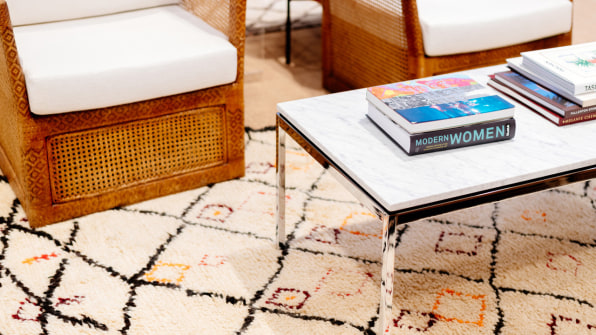
WeWork found the space for Thrive’s new office, and it is the official lease holder. (Thrive is committed to a two-year contract.) It’s an important detail, because it gives Thrive more flexibility than it might have otherwise. Real estate and architecture firms are currently contending with the reality that companies increasingly want options in their office arrangements. As CBRE’s 2019 Real Estate Market Outlook notes, corporations will expect landlords to be more malleable when it comes to lease terms and providing trendy amenities. That means building a brand and cultivating a sought-after selection of restaurants, activities, and retail shops to attract tenants (and their employees). The idea is to create an ecosystem in which a company like Thrive can grow.
WeWork sees the opportunity, too. Through its portfolio of spaces, relationships with landlords, and now design and construction capabilities, it sees a chance to embed with a company early. “What is great is–especially at our stage of growth, like even in a year, we’ve outgrown the space–that WeWork can help us relocate,” says Huffington. WeWork, by virtue of being a global company, can also provide its clients with design consistency across spaces–something that’s not easy when every new office is handled by a different architecture or design firm. Says Huffington: “We want to continue growing together as we grow around the world.”
–
This article first appeared in www.fastcompany.com
Seeking to build and grow your brand using the force of consumer insight, strategic foresight, creative disruption and technology prowess? Talk to us at +9714 3867728 or mail: info@groupisd.com or visit www.groupisd.com

